Papers by Edwin Arrigui Torres
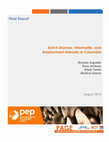
From the first half of the 2000s until 2014 the Colombian economy was under the influence of an o... more From the first half of the 2000s until 2014 the Colombian economy was under the influence of an oil and mining production and export boom that triggered the potential for Dutch disease effects. This issue was at the center of important policy (and political) debates and merits attention due to its manifested and potential impacts on several dimensions of the economy. As the boom has the potential to induce shifts in the sectorial composition of the economy, it may have significant effects on employment dynamics and on the evolution of the employment intensity, especially when the informal sector is sizable. We study the potential effects of this boom, had it extended as forecasted until 2014, before the sudden drop in international oil prices in 2015. For this, we use a recursive dynamic computable general equilibrium model, calibrated to a 2011 Social Accounting Matrix of the Colombian economy, in which activities are differentiated in terms of their formal and informal components,...
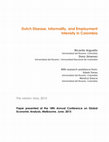
SSRN Electronic Journal, 2016
From the first half of the 2000s until 2014 the Colombian economy was under the influence of an o... more From the first half of the 2000s until 2014 the Colombian economy was under the influence of an oil and mining production and export boom that triggered the potential for Dutch disease effects. This issue was at the center of important policy (and political) debates and merits attention due to its manifested and potential impacts on several dimensions of the economy. As the boom has the potential to induce shifts in the sectorial composition of the economy, it may have significant effects on employment dynamics and on the evolution of the employment intensity, especially when the informal sector is sizable. We study the potential effects of this boom, had it extended as forecasted until 2014, before the sudden drop in international oil prices in 2015. For this, we use a recursive dynamic computable general equilibrium model, calibrated to a 2011 Social Accounting Matrix of the Colombian economy, in which activities are differentiated in terms of their formal and informal components, and suitable details are included to account for the stream of income the government receives from the booming activities. We find that resource shift and spending effects from the boom are sizeable, leading to a relative drop in exports of non-boom sectors and to shrinking output for most sectors of the economy, while employment in the formal sector and for skilled workers is favored. Furthermore, we find that the policy package designed by the Colombian government to face potential Dutch Disease effects on the economy, has limited impact for ameliorating the resource shift and spending effects.
Hotel general managers' use of consumer, expert, and internal feedback to improve service quality
One of the key human resource decisions made by any organization is the design of its compensatio... more One of the key human resource decisions made by any organization is the design of its compensation strategy. When choosing a compensation strategy, hospitality executives must make a variety of complex decisions that will ultimately impact a company's recruitment and retention efforts, as well as the attainment of organizational goals. This exploratory study looks at the decision making patterns of hospitality executives as it comes to compensation.
UNIVERSIDAD DE CUENCA FACULTAD DE CIENCIAS AGROPECUARIAS ESCUELA DE MEDICINA VETERINARIA Y ZOOTEC... more UNIVERSIDAD DE CUENCA FACULTAD DE CIENCIAS AGROPECUARIAS ESCUELA DE MEDICINA VETERINARIA Y ZOOTECNIA "Determinación del porcentaje de preñez con protocolos IATF en vacas lecheras utilizando benzoato y cipionato de estradiol" Tesis de grado previo a la obtención del título de " Médico veterinario zootecnista"
Hospitality Review, 2010
Companies have long recognized the importance of training and developing their managers to prepar... more Companies have long recognized the importance of training and developing their managers to prepare them for their short-and long-term careers. Formal management-development programs and other less formal means of management development abound in the hospitality industry. Therefore, one may ask whether the entry-level managers for whom these programs are designed perceive them to be effective. The present study explores management-development practices, procedures, and techniques, and their effects on job satisfaction and organizational commitment
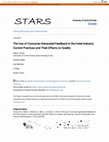
International Journal of Hospitality & Tourism Administration, 2015
The use of consumer generated feedback in the hotel industry: Current practices and their effects... more The use of consumer generated feedback in the hotel industry: Current practices and their effects on quality Consumer-generated feedback is hard to ignore these days. Word-of-Mouth has expanded beyond a customer's immediate friends and family; and with the help of technology reaches thousands of current and prospective guests. In light of this, scholars and practitioners are exploring the subject of consumer generated feedback. Today, most of the research regarding this subject focuses on the use of consumergenerated feedback to make purchase decisions. In contrast, the present study explores the use of such information for the purposes of improving hotel operations. Throughout the course of this paper, the researchers inquire about the amount of value placed on consumer-generated feedback, the relative importance placed on positive and negative feedback, and its effects on perceived quality. Furthermore, this study inquires as to the specific uses given to consumer-generated feedback in the hotel industry. It is the researchers' contention that valuing feedback has positive effects on perceived quality. The research concludes that hotels can use consumer-generated feedback to take actions such as modifying training programs, operating procedures, as well as identifying patterns of complaint and praise.
Revista de la Facultad de Medicina, 2015
Background. The Bogotá food-bank (BFF) has been aimed at retrieving (excess) fresh and manufactur... more Background. The Bogotá food-bank (BFF) has been aimed at retrieving (excess) fresh and manufactured products for delivery to vulnerable groups in Bogota and some municipalities in the surrounding department of Cundinamarca since 2001. However, a basic food basket (BFB) has been established for determining a standardised delivery structure. Objective. Determining the BFB for establishing permanent and additional components of such package per specific population. Materials and methods. This observational, descriptive study was organised into four phases. The frequency of activities
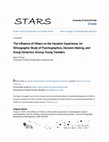
Journal of Hospitality Marketing & Management, 2015
The vacation experience is often enjoyed in the company of others. Whereas scholars have focused ... more The vacation experience is often enjoyed in the company of others. Whereas scholars have focused on the consumer behaviors of mature travelers, young travelers have received less attention. The present study explores customer-to-customer interactions among young travelers (in their 20s and 30s) within a European tour-group setting. Furthermore, it attempts to understand the influence such travelers have on one another. The decision-making patterns, role of the tour guide, group dynamics, and psychographic preferences are studied from an ethnographic approach. Results indicate that the young travel segment is not as homogeneous as previously conceived. Notable differences in activities, interests, and opinions (AIO) were observed. Additionally, several cases of en-route group purchase decisions were observed. This paper draws upon the concept of compatibility management to advocate for a more targeted approach in appealing to this particular market segment. Conclusions are made regarding the differences among trip participants and potential segmentation strategies are proposed.
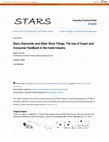
Journal of Hospitality and Tourism Management, 2014
The quality of a hotel can be evaluated by a series of stakeholders. Information can come from th... more The quality of a hotel can be evaluated by a series of stakeholders. Information can come from those who habitually evaluate or rate hotels (i.e., experts), from those who visit a hotel as part of their travel plans (i.e., consumers), and from those who work within the hotel or its corporate organization (i.e., internal stakeholders). This study focuses on the ways in which hotel General Managers use feedback from consumers and experts to improve or sustain service quality. In an environment of information overload, hotel management often must decide which sources to value the most and which to value the least. This study explored the amount of value General Managers place on such information. If given a similar service experience, whether consumers and experts would provide a similar rating is not clear. The present study explored whether a relationship existed between the perceptions of consumer feedback and customer satisfaction scores. Finally, similarities and differences between the various sources of feedback were studied.
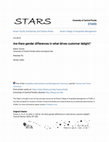
Tourism Review, 2014
Purpose-The present research sought to understand how male and female guests become delighted cus... more Purpose-The present research sought to understand how male and female guests become delighted customers. The similarities and differences are presented along with respective implications for theory and practice. Design/methodology/approach-Tourists were interviewed in an upscale Florida hotel for a period of three months. A total of 208 semi-structured interviews were conducted. The script for the interviews was based on an interview protocol used by Crotts et al. (2008). Adapted from a previous customer delight study (Torres & Kline, 2013), a codebook was developed to ascertain the salient themes that emerged during the interviews. Interviews were coded independently by three experienced reviewers using the process of content analysis. Findings-The results demonstrated, while men and women agreed on most aspects of the service experiences that led them to feel delighted, there were other aspects of the delight experience that seemed to vary by gender. More specifically, female guests were more likely to be delighted by employee friendliness and professionalism. In contrast, male tourists appeared to be more likely to be delighted by having their needs met efficiency and timeliness of service, and availability of complimentary amenities or upgrades. Research and Practical Implications-This study contributes to the existing literature by demonstrating that men and women can potentially be delighted by different aspects of the service experience. Such information may well benefit hospitality industry practitioners to deliver service experiences desired by each gender. Originality/value-Eckinci et al. (2008) proposed that the ultimate evaluation of customer experiences can be highly individualized with elements such as personality. The present research argues that the process of delighting customers might be more complex than originally conceived. Accordingly the results suggests: a) a universal set of criteria will tend to delight all guests, and b) a more specific set of criteria will potentially delight guests of a certain gender. Future research is encouraged to quantitatively validate the findings, as well as explore other factors that impact customer delight such as personality, age, income, and culture.
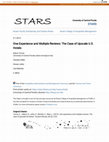
Tourism Review, 2013
Purpose-The present study aimed to understand the relationships between the various kinds of feed... more Purpose-The present study aimed to understand the relationships between the various kinds of feedback received by hospitality operators. Information from guests, experts, and internal sources are often received, valued, and processed in various ways. The researchers sought to further explore the usage of such feedback and implications for theory and practice. Design/methodology/approach-A survey was sent to hotel General Managers of four and five diamond properties around the United States using the listing of the American Automobile Association (AAA). A total of 140 responses were received. The researchers utilized correlations and canonical correlation analysis to help understand the relationships among the variables. Findings-The results of the study revealed moderate to strong correlations between improvement in consumer-generated feedback and customer satisfaction; between improvement in AAA ratings and customer satisfaction and mystery shopping scores. There were also moderate to high correlations among value placed in consumer-generated and that placed on other electronic forms of electronic feedback such as social networking, blogs, and online travel agency feedback. Canonical correlation was also performed among the variables in the various correlation matrices. Two statistically significant dimensions emerged. The most influential variables in the first dimension were value placed on TripAdvisor and value placed on meeting planner feedback. The second dimension, featured three influential variables: value placed on reviews in TripAdvisor, value placed on social networking, and perceived improvement in consumer-generated ratings. Research and Practical Implications-The present research revealed two distinct sets of General Managers: those who have a strong preference towards online feedback and those who place greater value in traditional sources of feedback such as letters from customers. Additionally, the researchers discovered some similarities between improvement in scores of experts and consumers. This in turn, points out to the existence of some universal aspects of service that appeal to both stakeholder groups. The different levels of value placed on various kinds of feedback points out to the need for tourism and hospitality operators to adopt a more comprehensive strategy to collect, analyze, and take appropriate actions based on such information. Originality/value-The researchers contribute to the nascent literature on consumer-generated feedback by exploring its relationship to other variables. Furthermore, the study of various sources of feedback (i.e. guests, experts, and operators) is often studied separately in the tourism literature. It was the aim of this study to explore all of these together in order to better understand their relationships, value, and uses.
Hotel Compensation Strategies: Perceptions of Top Industry Executives
Journal of Human Resources in Hospitality & Tourism, 2012
One of the key human resource decisions made by any organization is the design of its compensatio... more One of the key human resource decisions made by any organization is the design of its compensation strategy. When choosing a compensation strategy, hospitality executives must make a variety of complex decisions that will ultimately impact a company's recruitment and retention efforts, as well as the attainment of organizational goals. This exploratory study looks at the decision making patterns of
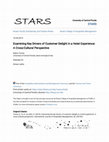
International Journal of Hospitality Management, 2014
Welcoming all guests is the calling shared by those who work in the hotel industry. Everyday hote... more Welcoming all guests is the calling shared by those who work in the hotel industry. Everyday hoteliers strive to provide a service of excellence to all of those who visit. This can be somewhat of a complex endeavor, as hotels receive guests from different nationalities and cultures. Previous research in the area of customer delight has revealed some of the factors that define and drive the customer delight experience. Despite the emerging literature on the subject, the question remains: are guest from different cultures likely to be delighted by different things? In the present study, the researchers conducted extensive semi-structured interviews (n= 228) with guests from different nationalities visiting the Central Florida area. The guests interviewed came predominantly from the United States, Brazil, Germany, and Canada. Using a process of content analysis, the researchers analyzed the drivers of customer delight and concluded that while some universal service elements exists, guests from different cultures can also be delighted by different services and amenities.
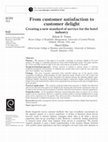
International Journal of Contemporary Hospitality Management, 2013
Purpose-The purpose of this paper is to provide a typology of customer delight in the hotel indus... more Purpose-The purpose of this paper is to provide a typology of customer delight in the hotel industry. By doing so, it identifies patterns by which hotels delight their guests. The paper explores the Torres and Kline model in light of the data and proposes an addition to the model. Design/methodology/approach-Content analysis is utilized to analyze letters of customer feedback provided by several hotels. A codebook was created, letters were coded by two raters and inter-rater reliability was calculated. Findings-The most frequently mentioned codes included: taking care of the guest's needs, exceptional friendliness, professionalism of staff, employees going outside of the call of duty and problem-solving skills. Based on this information the authors propose the following delight types: fulfillment delight, charismatic delight, professional delight, comparative delight, problem resolution delight. It was also found that the culture of an organization has an impact on the type of delight that is most prevalent. Practical implications-The research conducted helps hotel operators to identify the behaviors and actions that lead their guests to be delighted. By knowing this information, appropriate steps can be taken in the selection and development of staff that will lead towards greater customer engagement. Originality/value-In the hospitality literature, much information exists on what to do to correct negative service experiences. However, a relatively smaller number of articles highlight how to create great service experiences for the guests. This article provides a theoretically sound and practically useful framework to delight hotel guests in the hotel industry.

From satisfaction to delight: a model for the hotel industry
International Journal of Contemporary Hospitality Management, 2006
PurposeThis article seeks to develop a managerial model that will aid in the effective management... more PurposeThis article seeks to develop a managerial model that will aid in the effective management of customer relations. This study explains in detail the concepts of satisfaction and delight; their antecedents and potential outcomes.Design/methodology/approachAn extensive review of existing customer delight literature reveals the key concepts necessary for customer delight to occur.FindingsCustomer delight is a better measure of customer relationship management than customer satisfaction. Delight is likely to generate positive business results such as word‐of‐mouth communications, loyalty and increased profitability. Using existing literature a model is developed.Practical implicationsThe proposed model can be used by managers to achieve customer delight in their organizations. It can also be used to gain a better understanding of the process of managing customer relations.Originality/valueIn the last few years the concept of customer delight has been taking precedence over the con...

Reconstruction and electronic properties of β-Li3PS4 |Li2S interface
Journal of Physics D: Applied Physics, 2021
The morphology and properties of the interface between solid electrolyte and electrode have impor... more The morphology and properties of the interface between solid electrolyte and electrode have important impacts on all-solid-state lithium-sulfur batteries’ performance. We used the first-principles calculations to explore the interface between Li2S cathode and β-Li3PS4 (lithium thiophosphate, LPS) solid electrolyte, including lattice structure, mechanical, electrical properties, interface contact type, and charge distribution in real space. It is found that the interface is significantly reconstructed, and the Li atoms at the interface move mainly parallel to the interface plane. The interface density states introduce metallic properties, mainly contributed by the Li-s and S-s, -p orbitals in Li2S and S-p orbitals in LPS. The highest occupied molecular orbitals of the LPS electrolyte are lower than the electrochemical potential (Fermi level) of the Li2S cathode, thus the electrolyte and cathode materials are reasonable and stable in thermodynamics. Interface density of states shows e...



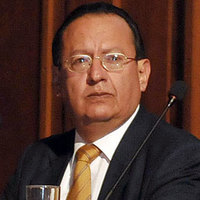


Uploads
Papers by Edwin Arrigui Torres